RENAULT SCENIC 2009 J84 / 2.G Engine And Peripherals EDC16 Workshop Manual
Manufacturer: RENAULT, Model Year: 2009, Model line: SCENIC, Model: RENAULT SCENIC 2009 J84 / 2.GPages: 273
Page 231 of 273
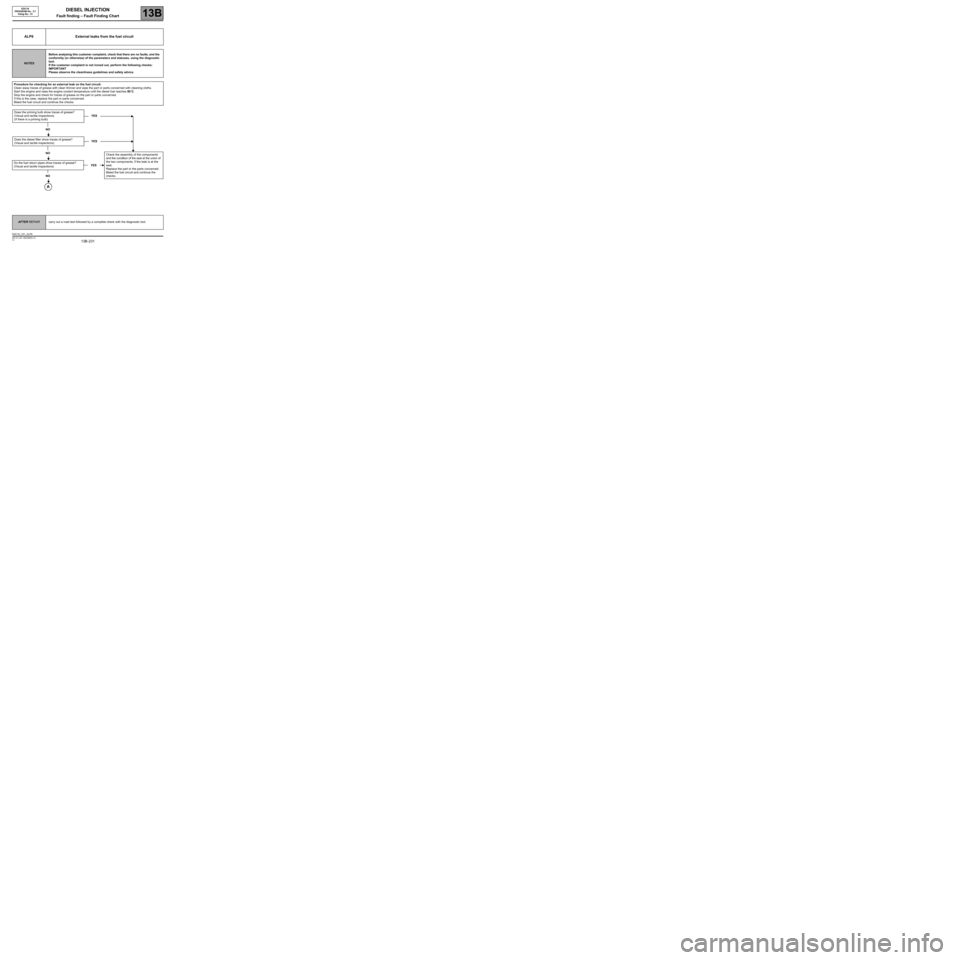
DIESEL INJECTION
Fault finding – Fault Finding Chart13B
13B -231V3 MR-372-J84-13B250$855.mif
EDC16
PROGRAM No.: C1
Vdiag No.: 51
ALP6 External leaks from the fuel circuit
NOTESBefore analysing this customer complaint, check that there are no faults, and the
conformity (or otherwise) of the parameters and statuses, using the diagnostic
tool.
If the customer complaint is not ironed out, perform the following checks:
IMPORTANT
Please observe the cleanliness guidelines and safety advice.
Procedure for checking for an external leak on the fuel circuit:
Clean away traces of grease with clean thinner and wipe the part or parts concerned with cleaning cloths.
Start the engine and raise the engine coolant temperature until the diesel fuel reaches 80˚C.
Stop the engine and check for traces of grease on the part or parts concerned.
If this is the case, replace the part or parts concerned.
Bleed the fuel circuit and continue the checks.
Does the priming bulb show traces of grease?
(Visual and tactile inspections)
(If there is a priming bulb)YES
NO
Does the diesel filter show traces of grease?
(Visual and tactile inspections)YES
NO
Do the fuel return pipes show traces of grease?
(Visual and tactile inspections)
NO
YESCheck the assembly of the components
and the condition of the seal at the union of
the two components, if the leak is at the
seal.
Replace the part or the parts concerned.
Bleed the fuel circuit and continue the
checks.
AFTER REPAIRcarry out a road test followed by a complete check with the diagnostic tool.
EDC16_V51_ALP6
Page 232 of 273

DIESEL INJECTION
Fault finding – Fault Finding Chart13B
13B -232V3 MR-372-J84-13B250$855.mif
EDC16
PROGRAM No.: C1
Vdiag No.: 51
ALP6
CONTINUED
Does the high pressure pump show traces
of grease?
(Visual and tactile inspections)YES
NO
Do the high pressure pipes and the injector
rail show traces of grease?
(Visual and tactile inspections)YES
NO
Do the injectors show traces of grease?
(Visual and tactile inspections)YES
NO
End of fault finding.Location of the leak: Where does the leak
appear?
On the
componenton theunion/
join
–If the leak is on the component,
replace this and the high pressure
pipe(s) at the same time as the
component.
–If the leak is on the join of a high pressure
pipe and the component, remove the
high pressure pipe and perform a visual
inspection of the unions: if you find
damaged unions, change the faulty
component and the high pressure
pipe(s) removed at the same time as the
component.
Reminder:
do not replace the rail, pump or injector unless the union is found to be damaged during the visual
inspections.
Bleed the fuel circuit and continue the checks.
AFTER REPAIRcarry out a road test followed by a complete check with the diagnostic tool.
Page 233 of 273
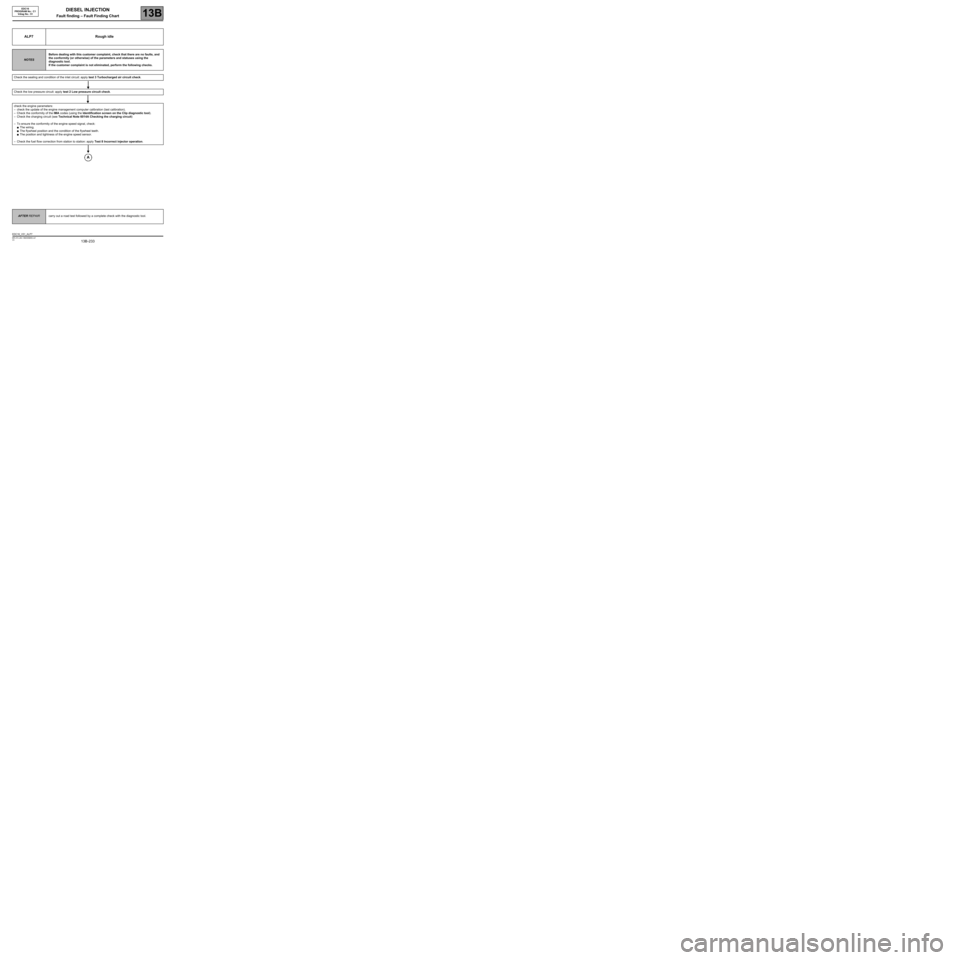
DIESEL INJECTION
Fault finding – Fault Finding Chart13B
13B -233V3 MR-372-J84-13B250$855.mif
EDC16
PROGRAM No.: C1
Vdiag No.: 51
ALP7 Rough idle
NOTESBefore dealing with this customer complaint, check that there are no faults, and
the conformity (or otherwise) of the parameters and statuses using the
diagnostic tool.
If the customer complaint is not eliminated, perform the following checks.
Check the sealing and condition of the inlet circuit: apply test 3 Turbocharged air circuit check.
Check the low pressure circuit: apply test 2 Low pressure circuit check.
check the engine parameters:
–check the update of the engine management computer calibration (last calibration).
–Check the conformity of the IMA codes (using the Identification screen on the Clip diagnostic tool).
–Check the charging circuit (see Technical Note 6014A Checking the charging circuit)
–To ensure the conformity of the engine speed signal, check:
●The wiring.
●The flywheel position and the condition of the flywheel teeth.
●The position and tightness of the engine speed sensor.
–Check the fuel flow correction from station to station: apply Test 8 Incorrect injector operation.
AFTER REPAIRcarry out a road test followed by a complete check with the diagnostic tool.
EDC16_V51_ALP7
Page 234 of 273
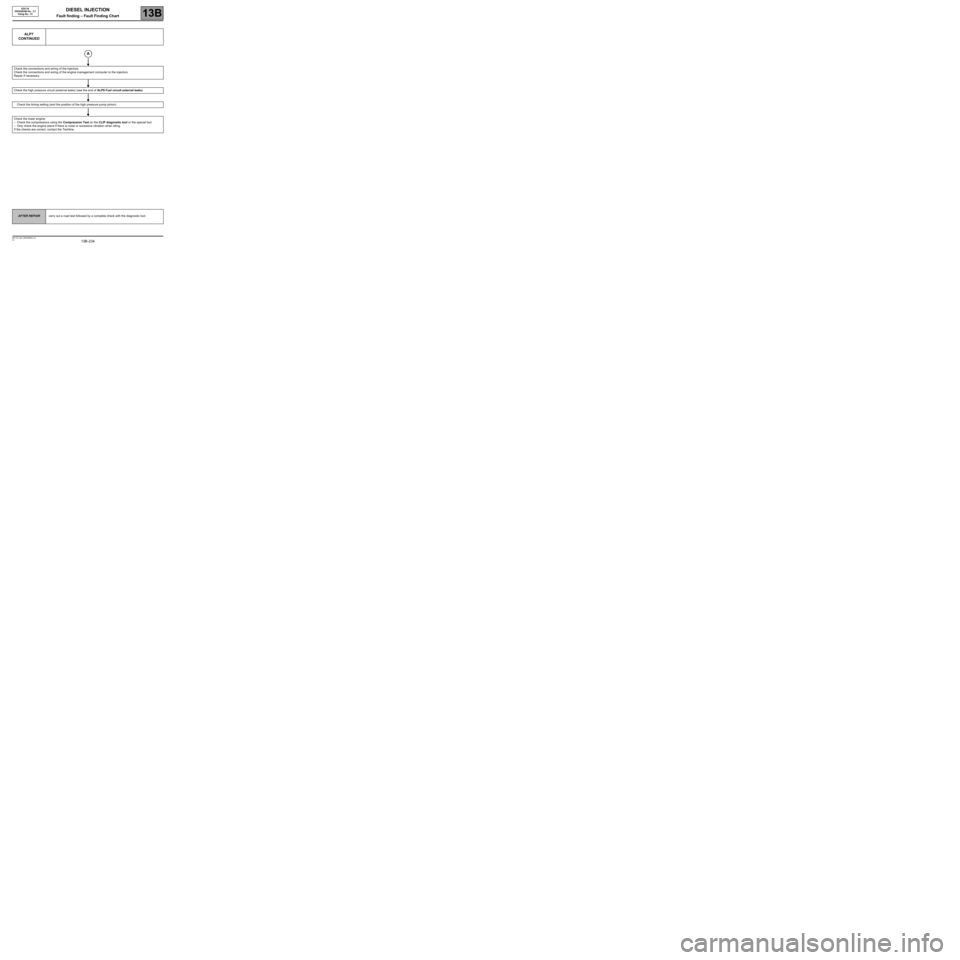
DIESEL INJECTION
Fault finding – Fault Finding Chart13B
13B -234V3 MR-372-J84-13B250$855.mif
EDC16
PROGRAM No.: C1
Vdiag No.: 51
ALP7
CONTINUED
Check the connections and wiring of the injectors.
Check the connections and wiring of the engine management computer to the injectors.
Repair if necessary.
Check the high pressure circuit (external leaks) (see the end of ALP6 Fuel circuit external leaks)
Check the timing setting (and the position of the high pressure pump pinion)
Check the lower engine:
–Check the compressions using the Compression Test on the CLIP diagnostic tool or the special tool.
–Only check the engine stand if there is noise or excessive vibration when idling.
If the checks are correct, contact the Techline.
AFTER REPAIRcarry out a road test followed by a complete check with the diagnostic tool.
Page 235 of 273
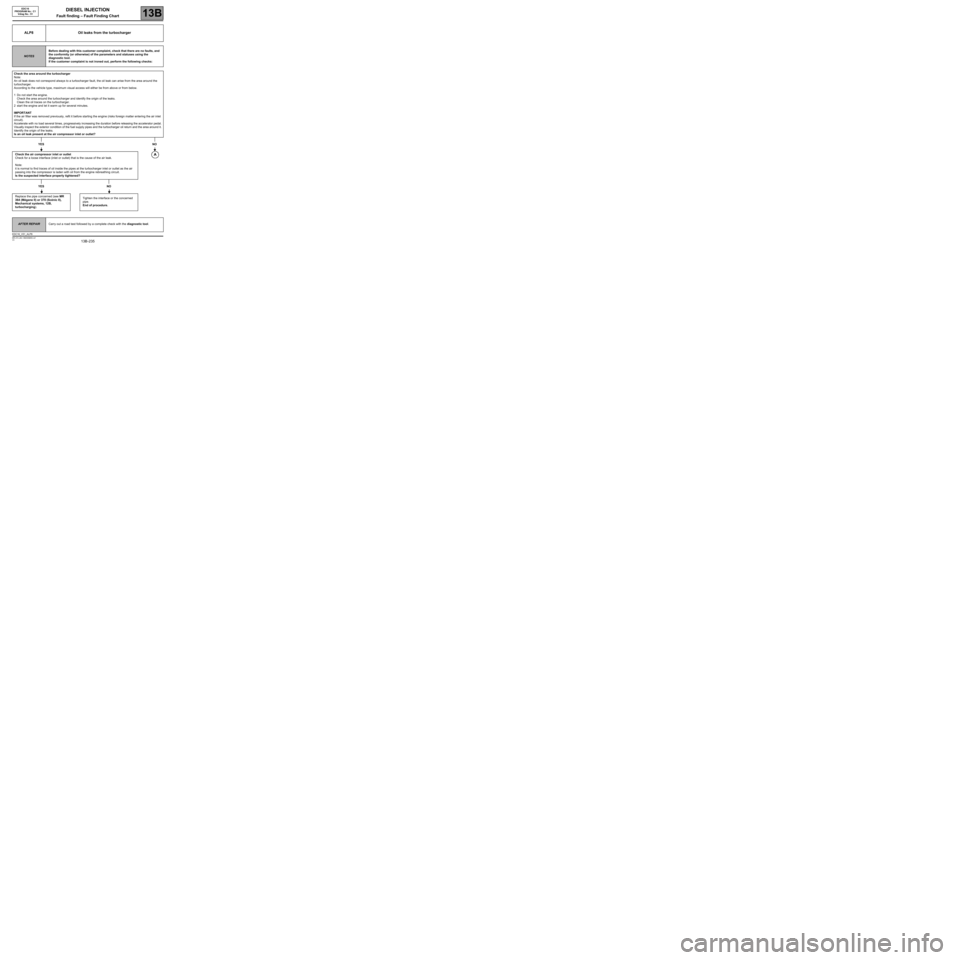
DIESEL INJECTION
Fault finding – Fault Finding Chart13B
13B -235V3 MR-372-J84-13B250$855.mif
ALP8 Oil leaks from the turbocharger
NOTESBefore dealing with this customer complaint, check that there are no faults, and
the conformity (or otherwise) of the parameters and statuses using the
diagnostic tool.
If the customer complaint is not ironed out, perform the following checks:
Check the area around the turbocharger
Note:
An oil leak does not correspond always to a turbocharger fault, the oil leak can arise from the area around the
turbocharger.
According to the vehicle type, maximum visual access will either be from above or from below.
1Do not start the engine.
Check the area around the turbocharger and identify the origin of the leaks.
Clean the oil traces on the turbocharger.
2start the engine and let it warm up for several minutes.
IMPORTANT
If the air filter was removed previously, refit it before starting the engine (risks foreign matter entering the air inlet
circuit).
Accelerate with no load several times, progressively increasing the duration before releasing the accelerator pedal.
Visually inspect the exterior condition of the fuel supply pipes and the turbocharger oil return and the area around it.
Identify the origin of the leaks.
Is an oil leak present at the air compressor inlet or outlet?
YESNO
Check the air compressor inlet or outlet
Check for a loose interface (inlet or outlet) that is the cause of the air leak.
Note:
it is normal to find traces of oil inside the pipes at the turbocharger inlet or outlet as the air
passing into the compressor is laden with oil from the engine rebreathing circuit.
Is the suspected interface properly tightened?
YES NO
Replace the pipe concerned (see MR
364 (Mégane II) or 370 (Scénic II),
Mechanical systems, 12B,
turbocharging).Tighten the interface or the concerned
pipe.
End of procedure.
AFTER REPAIRCarry out a road test followed by a complete check with the diagnostic tool.
EDC16
PROGRAM No.: C1
Vdiag No.: 51
EDC16_V51_ALP8
Page 236 of 273
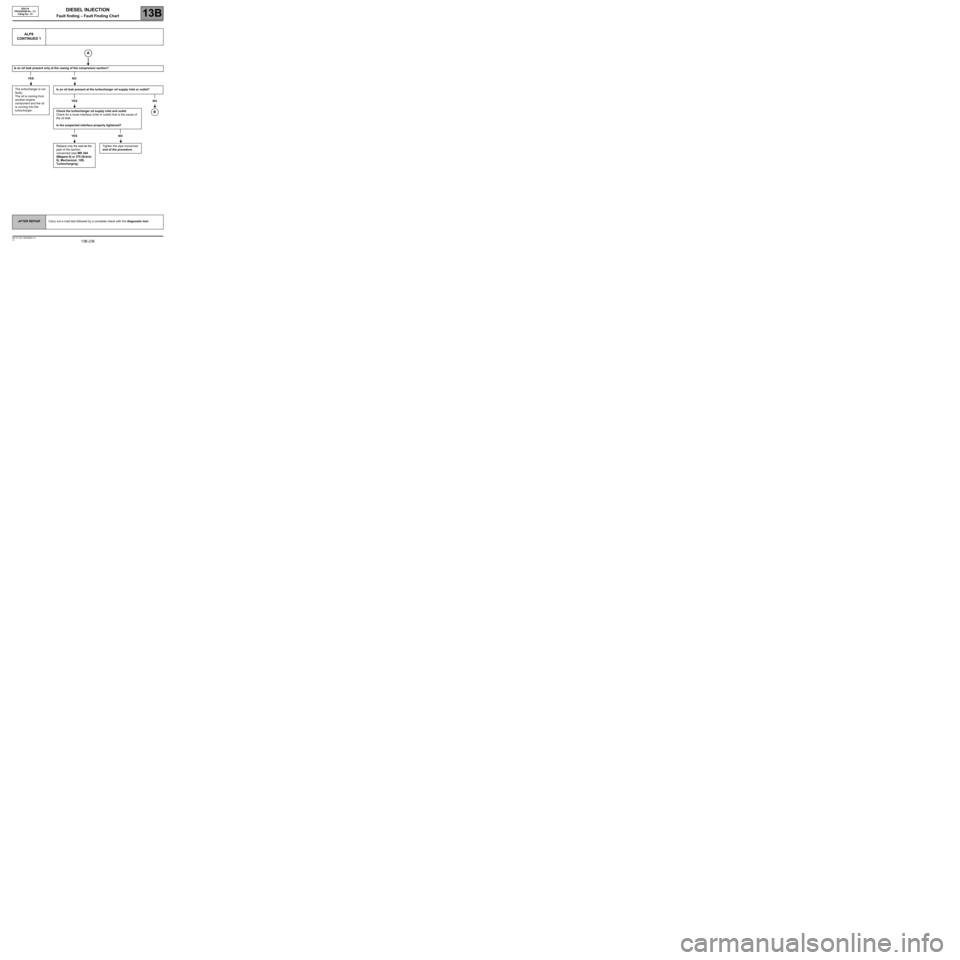
DIESEL INJECTION
Fault finding – Fault Finding Chart13B
13B -236V3 MR-372-J84-13B250$855.mif
EDC16
PROGRAM No.: C1
Vdiag No.: 51
ALP8
CONTINUED 1
Is an oil leak present only at the casing of the compressor section?
YES NO
The turbocharger is not
faulty.
The oil is coming from
another engine
component and the oil
is running into the
turbocharger.Is an oil leak present at the turbocharger oil supply inlet or outlet?
YES NO
Check the turbocharger oil supply inlet and outlet
Check for a loose interface (inlet or outlet) that is the cause of
the oil leak.
Is the suspected interface properly tightened?
YES NO
Replace only the seal or the
pipe of the section
concerned (see MR 364
(Mégane II) or 370 (Scénic
II), Mechanical, 12B,
Turbocharging).Tighten the pipe concerned.
end of the procedure
B
AFTER REPAIRCarry out a road test followed by a complete check with the diagnostic tool.
Page 237 of 273
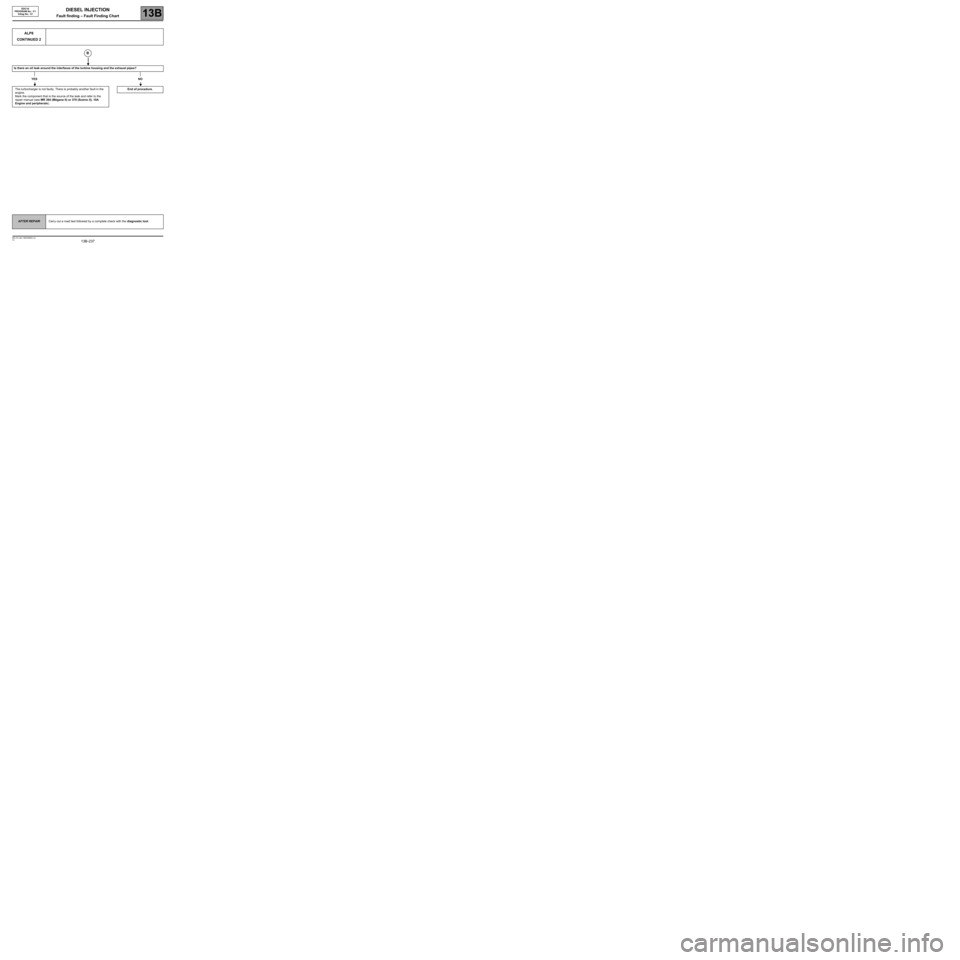
DIESEL INJECTION
Fault finding – Fault Finding Chart13B
13B -237V3 MR-372-J84-13B250$855.mif
EDC16
PROGRAM No.: C1
Vdiag No.: 51
ALP8
CONTINUED 2
Is there an oil leak around the interfaces of the turbine housing and the exhaust pipes?
YESNO
The turbocharger is not faulty. There is probably another fault in the
engine.
Mark the component that is the source of the leak and refer to the
repair manual (see MR 364 (Mégane II) or 370 (Scénic II), 10A
Engine and peripherals).End of procedure.
B
AFTER REPAIRCarry out a road test followed by a complete check with the diagnostic tool.
Page 238 of 273
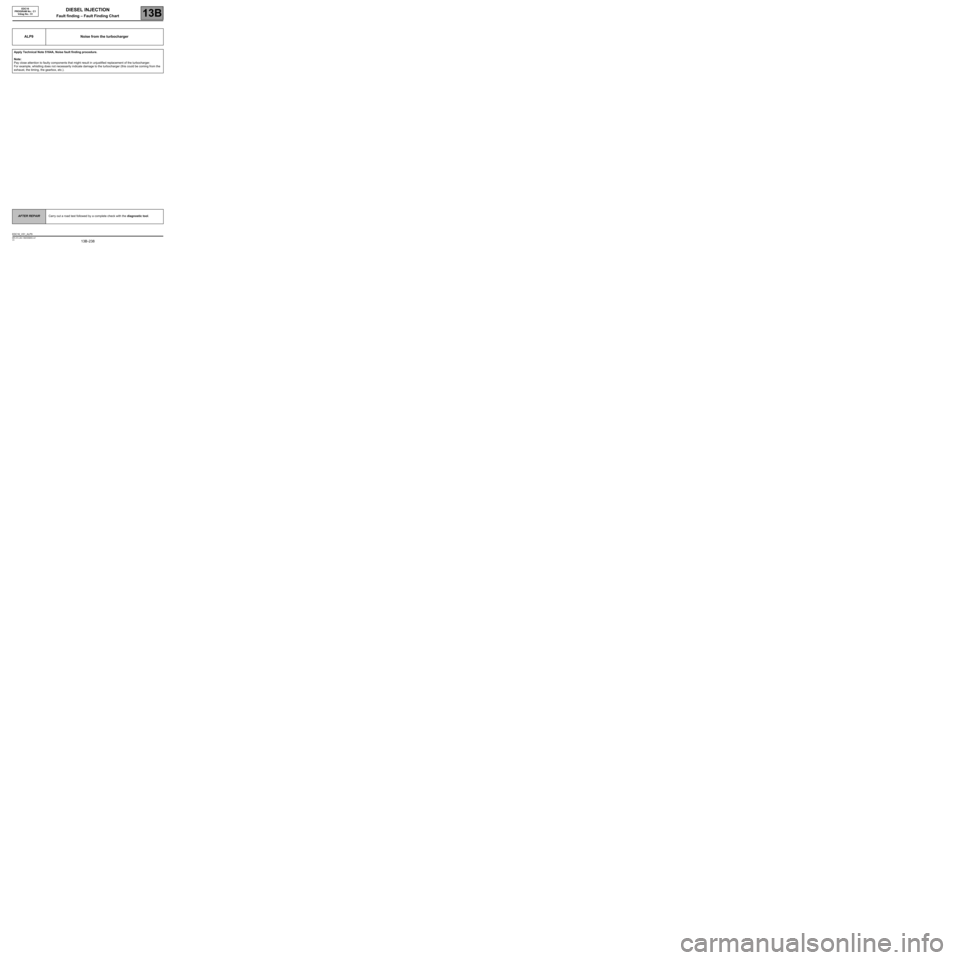
DIESEL INJECTION
Fault finding – Fault Finding Chart13B
13B -238V3 MR-372-J84-13B250$855.mif
EDC16
PROGRAM No.: C1
Vdiag No.: 51
ALP9 Noise from the turbocharger
Apply Technical Note 5164A, Noise fault finding procedure.
Note:
Pay close attention to faulty components that might result in unjustified replacement of the turbocharger.
For example, whistling does not necessarily indicate damage to the turbocharger (this could be coming from the
exhaust, the timing, the gearbox, etc.).
AFTER REPAIRCarry out a road test followed by a complete check with the diagnostic tool.
EDC16_V51_ALP9
Page 239 of 273
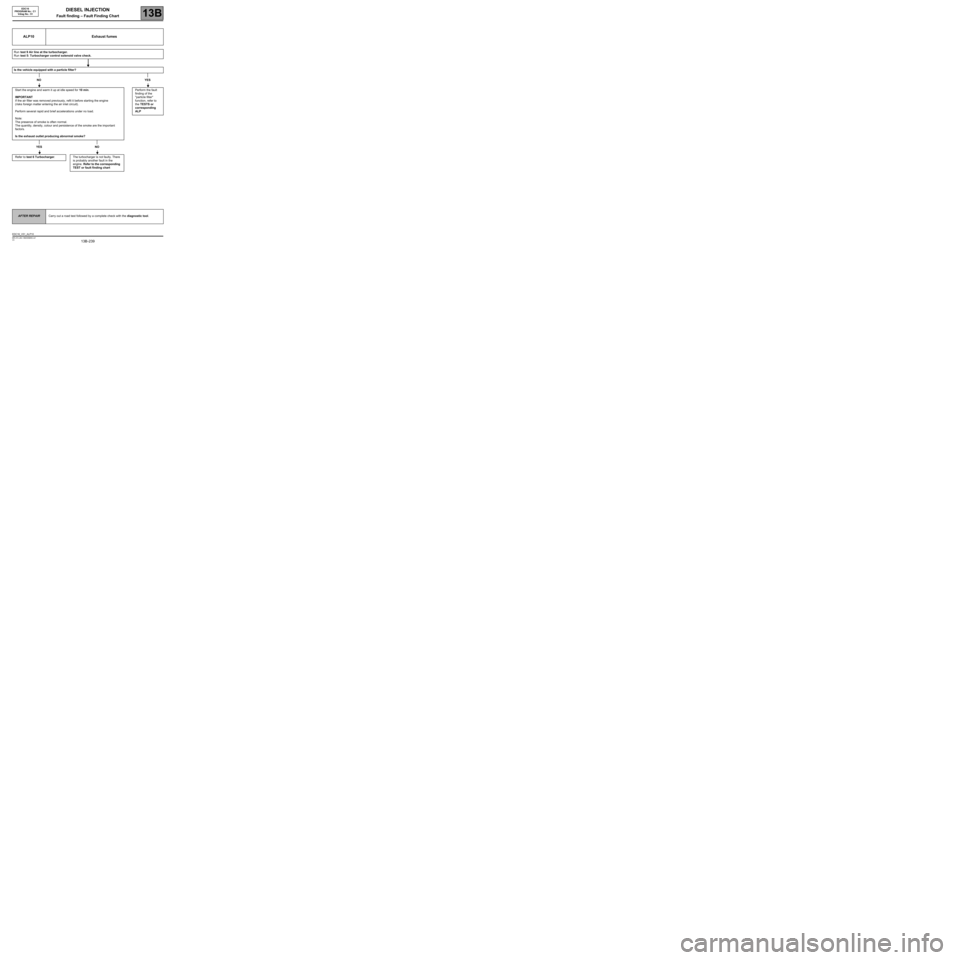
DIESEL INJECTION
Fault finding – Fault Finding Chart13B
13B -239V3 MR-372-J84-13B250$855.mif
EDC16
PROGRAM No.: C1
Vdiag No.: 51
ALP10 Exhaust fumes
Run test 9 Air line at the turbocharger.
Run test 5: Turbocharger control solenoid valve check.
Is the vehicle equipped with a particle filter?
NOYES
Start the engine and warm it up at idle speed for 10 min.
IMPORTANT
If the air filter was removed previously, refit it before starting the engine
(risks foreign matter entering the air inlet circuit).
Perform several rapid and brief accelerations under no load.
Note:
The presence of smoke is often normal.
The quantity, density, colour and persistence of the smoke are the important
factors.
Is the exhaust outlet producing abnormal smoke?Perform the fault
finding of the
"particle filter"
function, refer to
the TESTS or
corresponding
ALP
YES NO
Refer to test 6 Turbocharger.The turbocharger is not faulty. There
is probably another fault in the
engine. Refer to the corresponding
TEST or fault finding chart
AFTER REPAIRCarry out a road test followed by a complete check with the diagnostic tool.
EDC16_V51_ALP10
Page 240 of 273
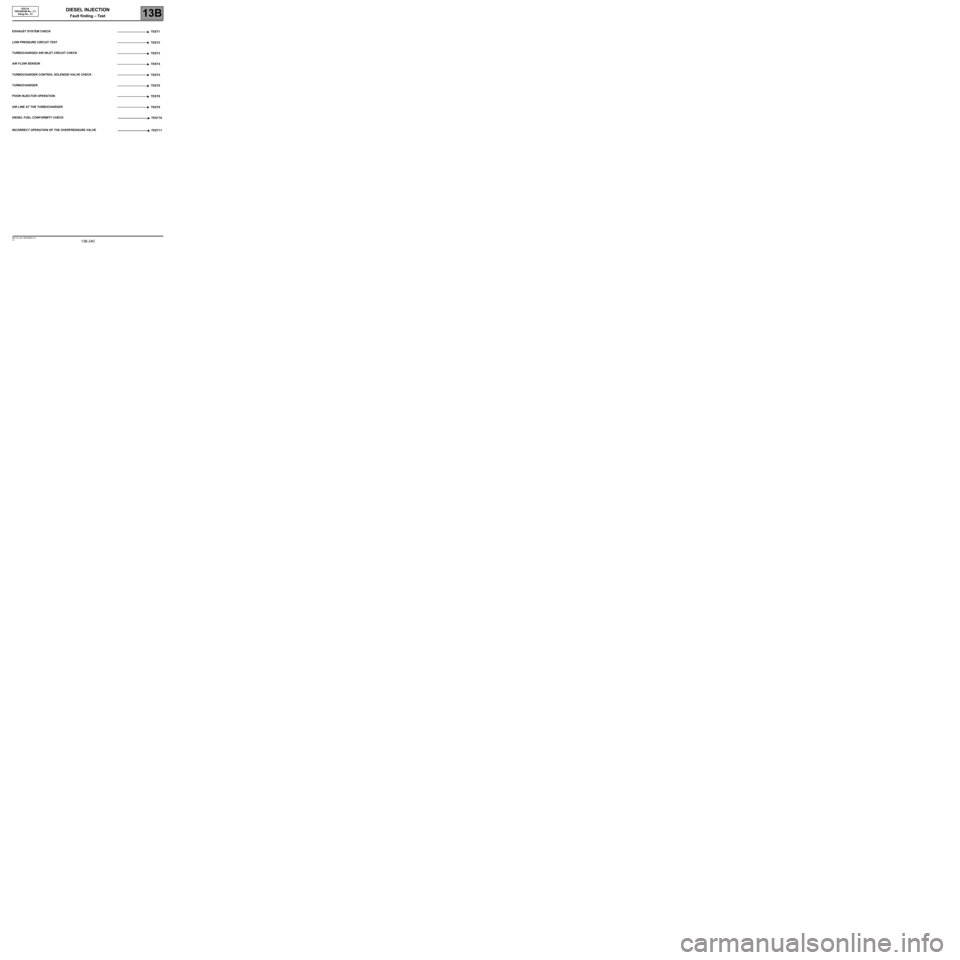
DIESEL INJECTION
Fault finding – Test13B
13B -240V3 MR-372-J84-13B250$900.mif
EDC16
PROGRAM No.: C1
Vdiag No.: 51DIESEL INJECTION
Fault finding – Test
EXHAUST SYSTEM CHECK
TEST1
LOW PRESSURE CIRCUIT TEST
TEST2
TURBOCHARGED AIR INLET CIRCUIT CHECK
TEST3
AIR FLOW SENSOR
TEST4
TURBOCHARGER CONTROL SOLENOID VALVE CHECK
TEST5
TURBOCHARGER
TEST6
POOR INJECTOR OPERATION
TEST8
AIR LINE AT THE TURBOCHARGER
TEST9
DIESEL FUEL CONFORMITY CHECK
TEST10
INCORRECT OPERATION OF THE OVERPRESSURE VALVE
TEST11